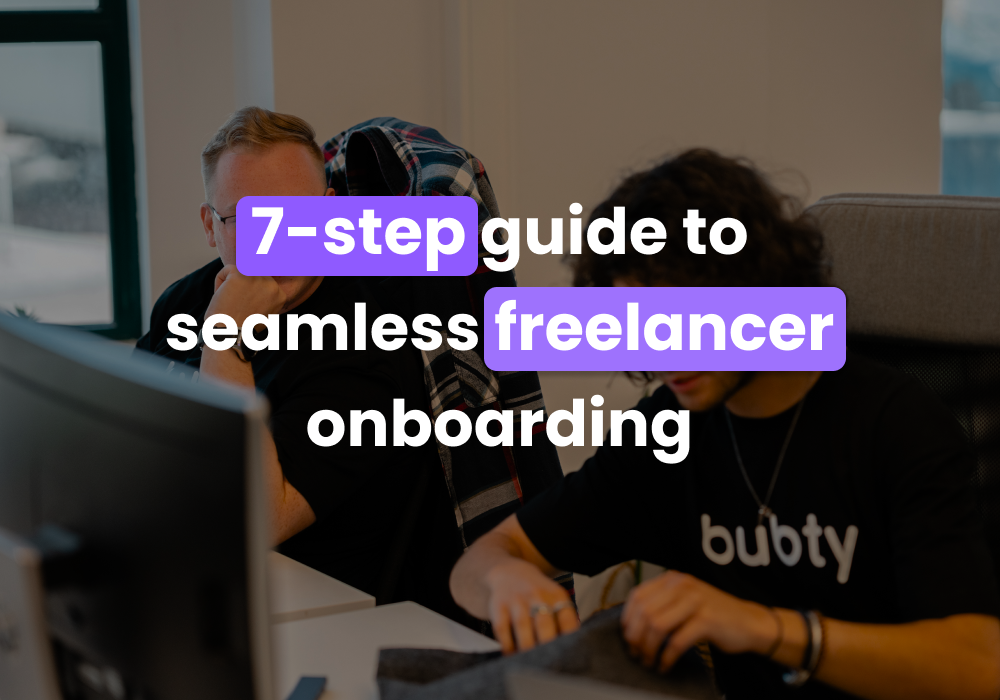Traditionally, onboarding was a slightly neglected part of the candidate experience. But, nowadays, most companies understand its importance. For instance, they know that a negative onboarding experience can double the chances of an employee seeking another opportunity. Conversely, a good onboarding experience correlates with employees sticking with your company for three years or more.
The bottom line: Onboarding matters
However, even organisations with first-rate onboarding strategies for hiring full-time employees often struggle to know what to do with freelancers. Although freelancers typically don’t work with you for long periods, their onboarding experience is still impactful. For instance, poor onboarding can adversely impact your working relationship, however short. Such obstacles might include misunderstandings that can slow your project's progress, create unnecessary paperwork, and more.
In short, establishing an excellent freelancer onboarding process is critical to ensuring you and your freelancers get off on the right foot. So, in this article, we’ve prepared a quick step-by-step guide to seamless freelancer onboarding to help you achieve precisely that.
Sound good? Grab a cup of coffee, and let’s dive in!
1. Collect Your Freelancer’s Contact Details
It might seem obvious, but it’s too easy for even the most basic of information to slip through the cracks - especially if you’re looking to hit the ground running as quickly as possible.
So, once you’ve identified the right freelancer for your job, the first step is to ensure you have their up-to-date information. This includes their:
-
Full name
-
Phone number and email address
-
ID or EIN number
-
Resume, references, and/or portfolio of past work
This information is crucial for ensuring effective communication throughout your project and, of course, providing timely payment upon completion. Not only that, but once you have these details, you can add the contractor to your own freelancer network. That way, you have all the details at your fingertips to re-hire them again in the future.
2. Automate Your Paperwork - Save and Sign All Required Documents
As many as 58% of organisations say their onboarding program focuses on processes and paperwork. This isn’t surprising when you consider how many documents there are to sign. But fortunately, you can save lots of time by automating this process.
For instance, new freelancers who aren’t on your traditional payroll must sign a work contract, NDA, and IP agreement. But sometimes, additional legal documents are necessary. For example, Data Protection Agreements, Non-Compete Agreements, and more.
This is where a freelancer management system becomes vital. An FMS allows you to store all your contracts and documents in one secure place to efficiently standardize the process. From there, you can automatically send the required documents to your freelancers during the onboarding process. Needless to say, this is much easier and quicker than manually handling these tasks.
That said, some freelancer management systems like Bubty go one step further by allowing you to customize workflows per freelancer role. Bubty comes with an easy-to-use drag-and-drop workflow editor. All you have to do is input which documents, portfolios, and information you require from each type of freelancer during onboarding. Then Bubty will handle the rest for you!

Not only does this save a lot of time of effort, but automating your paperwork is also vital for compliance. For example, it’s against the law in some states to fail to get your contractors to sign a contract (for example, the NY Freelancer law.) Fortunately, a freelancer management system like Bubty eradicates the likelihood of human error, ensuring that no document or signature is forgotten.
3. Collect and Share Freelancer Payment Details With Your Finance Team
Although we tend to associate payment with the end of the project, it’s wise to collect and share your freelancer’s payment details with your finance team from the get-go. That way, all the necessary people are primed and ready to pay your freelancers on time and without hassle. After all, your finance team will have to perform 'Know Your Customer' and 'Anti-Money Laundry' checks before they can send any payments. So completing this step during the onboarding process works wonders for streamlining the payment process later down the line.
You’ll also have to collect proper tax documentation. For freelancers, this often means W8 or W9 documents. Again, don’t wait until the end of the project to request these forms. Any delay in receiving their hard-earned money may jeopardize your working relationship.
With that said, you first need to get your contractor’s payment details and ask them about their preferred payment method. In many countries, it’s a legal requirement to specify how the freelancer will be paid in their contract. But, legalities aside, this is still worth factoring into your onboarding process as it ensures both parties are on the same page about payment installments, deliverables, and the agreed-upon rates.
Asking for the freelancer’s payment details is also an excellent way to check a new freelancer’s credibility. Suppose they, for any reason, struggle to provide a standard ID or a regular payment method. In that case, it might be wise to look for other talents elsewhere.
4. Equip Your Freelancers
Seamless onboarding should ensure that contractors have everything they need for their first day on the project. In some cases, this might mean access to the relevant software. If that applies to you, be sure to request that your IT team gives them the necessary passwords, usernames, links, etc., to access what they need to do the job justice.
It’s vital to sort this out ahead of time as your IT team may well be swamped with other requests when your freelancer is ready to rock up to work. After all, you don’t want them sitting at their desk waiting idly - it’s both a waste of your money and your freelancer’s time.
If you’re unsure what your freelancer will need, be sure to ask so that you can prepare ahead of time.
Finally, it’s worth documenting any access you grant contractors to equipment and/or software and getting their signatures for these items. This helps ensure off-boarding is as seamless as onboarding.
5. Specify Your Business Processes and Requirements
Aside from equipment and software access, freelancers also need guidance on how to successfully start the project. However, your HR manager might not be well-informed about department-specific processes. That’s why it’s a good idea to get together with relevant departments before hiring freelancers and creating documentation templates.
These documents should include all the information freelancers might need before they start. For instance:
-
Who freelancers should turn to if they have questions about payment, processes, systems, tools, or anything else. Include the name and email address of relevant contacts.
-
Your processes. Does your organization have specific file naming conventions that freelancers should know about? How do they submit work for review? Are there particular routines for interacting with projects and customers? Outlining this information allows freelancers to be better prepared for their jobs, which helps negate unnecessary friction.
-
Office-related information. Suppose freelancers are joining you in the office. In that case, they’ll need information like your office hours, access codes, safety procedures, etc.
6. Document and Review Your Onboarding Checklist for Freelancers with HR
In many companies, HR teams are responsible for recruiting, onboarding, and training regular employees. But they’re not always actively involved in the management of freelancers. Nevertheless, HR is still the expert in optimizing your company’s stance on financial, legal, and managerial matters. As such, you should always review your freelancer onboarding processes with them.
So, be sure to document your freelancer onboarding checklist and share it with HR. They'll be able to spot any potential shortcomings and help standardize and optimize the process.
7. Check-In
The final step is to ensure freelancers feel welcome and acknowledged and get a chance to ask any questions they might have. In light of that, checking in with freelancers during onboarding is just as important as checking in on any other new hire. After all, freelancers must orient themselves amidst new team members and processes. Like anyone else, they’ll want to feel settled as soon as possible.
So, ask them how everything is going once the project’s underway, and schedule regular check-ins for longer projects. This allows you and the freelancer to discuss the project's status, address any concerns, and provide feedback and praise where it’s due.
Are You Ready to Onboard Your Next Freelancer?
In this article, we’ve covered all the seven crucial steps to ensuring seamless freelancer onboarding. No part of the onboarding process needs to be particularly complex. The important thing is to keep a checklist and standardize the process so that each onboarding is the same and can be optimized accordingly.
The best way to streamline onboarding is to rely on the help of freelancer management systems. Bubty can help you prepare all the necessary paperwork for freelancers ahead of time. Plus, you can send and request documents using custom automated workflows tailored to each type of freelancer you’re looking to hire. Bubty also helps you ensure compliance, manage freelance work and projects, and automate the payment process to get invoices paid on time.
Interested? Why not book a demo today to see how we can help you improve your onboarding?




